
The Sycamore Historic District is a meandering area encompassing 99 acres (400,000 m2) of the land in and around the downtown of the DeKalb County, Illinois county seat, Sycamore. The area includes historic buildings and a number of historical and Victorian homes. Some significant structures are among those located within the Historic District including the DeKalb County Courthouse and the Sycamore Public Library. The district has been listed on the National Register of Historic Places since May 2, 1978.

The East Grove Street District is a residential historic district located on the 400 through 700 blocks of East Grove Street in Bloomington, Illinois. The district includes 43 houses and apartment buildings, 25 of which are considered contributing buildings. The houses in the district were built between 1855 and 1915 for many of Bloomington's upper middle class residents. Due to a building boom between 1880 and 1900, the then-popular Queen Anne style is the most prevalent in the district. Other popular architectural styles in the district include Greek Revival homes from the 1850s, Italianate homes built between 1860 and 1880, and Arts and Crafts homes built in the 1900s.
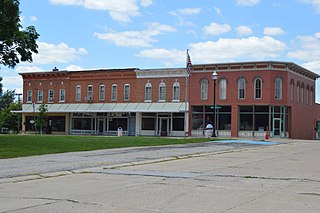
Barry Historic District is a historic district comprising the commercial and older residential areas of Barry, Pike County, Illinois. Barry was founded as an agricultural community in the 1830s, and most of its development took place between its founding and the Civil War. The city's commercial core, however, was mainly built in 1894 after a fire destroyed most of the existing commercial buildings. The 1894 buildings are well-preserved examples of typical commercial architecture of the period, and several have metal storefronts. The district also includes Barry's "Diamond Hill" residential district on Mortimer Street east of Brown Street and several other residential sections. Prominent architectural styles in the residential areas include Italianate, Queen Anne, Carpenter Gothic, and vernacular types from the late 19th century.

Griggsville Historic District is a historic district comprising the oldest sections of the city of Griggsville, Pike County, Illinois. The district encompasses Griggsville's commercial center and two of its residential areas. Development began in the commercial center in the 1830s; however, most of its significant buildings were built between 1850 and 1880. These buildings are mainly two-story brick structures, and several have Italianate influences. The southern residential area also has a heavy Italianate influence, as most of the homes there are designed in the style. The northwest residential area includes a variety of architectural styles and has a more rural character.

The Belleville Historic District is a historic district in Belleville, Illinois. The primarily residential district consists of an irregularly shaped area on the east side of Belleville. 70 buildings are included in the district, all of which are contributing buildings to its historic character. The homes in the district represent Belleville's residential development from 1830 to 1900. Many of the houses were designed in a vernacular cottage style popular among the city's German immigrants; while common in Belleville and other Metro-East cities, the style is little seen elsewhere in the state. Formal architectural styles such as Greek Revival and Italianate are also prevalent in the district.

The Lebanon Historic District is a historic district composed of the areas of Lebanon, Illinois, developed prior to 1900. The district includes five distinct areas of Lebanon: the city's main commercial district, the neighborhood around McKendree University, two residential districts, and an archaeological site at the city limits. Development in Lebanon began in the 1820s, and McKendree University was founded in 1828. The oldest building from this period, the Mermaid House Hotel, is a Federal structure dating to 1830. The city received an influx of German immigrants from the 1830s onward, which affected the city's development. In the 1850s and 1860s, a railroad opened in the city and several local industries developed; however, the city retained the character of a small college town and never developed into an industrial or trade center.
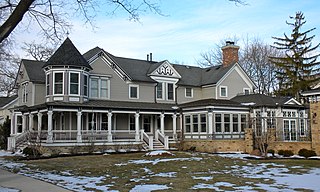
The Barrington Historic District is a 92-acre (37 ha) historic district in Barrington, Illinois. The district encompasses a residential area in southwest Barrington and is roughly bounded by the Chicago and Northwestern Railway tracks to the north, Dundee Avenue to the west, E. Hillside and W. Coolidge Streets to the south, and S. Spring and S. Grove Streets to the east. The large majority of the district is in Cook County, but about one square block is in Lake County, Illinois.

The Jacksonville Historic District is a historic district encompassing 696 buildings in Jacksonville, Illinois. The buildings in the district were mainly constructed from 1829 to the 1930s and represent nearly every popular architectural style from the period. The Greek Revival, Italianate, and Queen Anne styles are especially prevalent in the district. The district includes the campuses of two prominent Jacksonville educational institutions: Illinois College and the Illinois School for the Deaf. Illinois College, the first college in Illinois to grant a degree, was founded in 1829; its first building, Beecher Hall, is the oldest building in the district. The Illinois School for the Deaf was established in 1839 by the Illinois Legislature for the education of hearing-impaired students. Aside from these two institutions, the majority of the district is residential and includes many of Jacksonville's most historically and architecturally significant homes. The district is considered to have retained its historic character well, as 650 of its buildings are considered contributing buildings and the number of recent buildings in the district has been called "remarkably low".

The Red Bud Historic District is a commercial and residential historic district which includes the originally developed portions of Red Bud, Illinois, United States. The district is centered on Main and Market Streets, the primary roads through the city. One hundred and ninety-five buildings and structures, including 138 contributing buildings, are included in the district. The oldest building in the district, the Greek Revival Durfee and Crozier Store, dates from 1855, seven years after Red Bud was platted. The community rapidly developed between the 1850s and 1880s, and architectural styles from these decades are prominently represented in the district. The Federal and Italianate styles are the two most prevalent in the district, the latter being an especially popular commercial design. Gothic Revival churches, Second Empire buildings, and a number of German-style cottages can also be found in the district. Development and population growth in Red Bud remained stable in Red Bud from the 1890s through most of the 20th century, and the historically developed core makes up most of the modern city.

The Christian Hill Historic District is a historic district and neighborhood in Alton, Illinois. The district is located west of Alton's central business district on a bluff overlooking the Mississippi River. A primarily residential area, the district includes 274 buildings, of which 266 are contributing buildings to its historic character. Development in the district began in the 1830s; in addition to residential development, the Illinois State Prison was constructed in the neighborhood in 1833. While Alton's economy declined during the Panic of 1837, development in the district continued through the early 20th century, and Christian Hill became a desirable neighborhood for Alton residents. The hill acquired its name from, Saints Peter and Paul Church, a Catholic church built in the 1850s which was the cathedral of the Diocese of Alton until the diocese moved to Springfield.

The Middletown Historic District is a historic district in Alton, Illinois. The primarily residential district includes portions of Alton's Middletown and Hunterstown neighborhoods and comprises 653 buildings, 613 of which are contributing buildings. Settlement in the district dates to the original plat of Alton in 1817, which included the southern half of Middletown. Development in the district continued through the 19th century and into the 20th, spanning all of Alton's early history. The district also represents multiple eras of Alton's architectural history. Most early houses in the district were designed in the Federal style, while the Italianate and Queen Anne styles were predominant in the latter half of the 19th century.
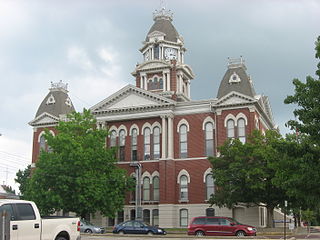
The Shelbyville Historic District is a historic district encompassing the core of Shelbyville, Illinois. The district includes 398 buildings, 293 of which are contributing buildings. The section of Shelbyville laid out at the city's founding in 1827 forms the center of the district. Shelbyville's public square, which includes the 1880 Shelby County Courthouse and a veterans' memorial, is the central feature of this part of the historic district. The original section of Shelbyville also includes significant commercial and government buildings. The district also includes Shelbyville's oldest residential areas, which developed out from the 1827 core. The Italianate style is the most prominent architectural style in the district, both in homes and commercial buildings; other common architectural styles include Greek Revival, Gothic Revival, Second Empire, and Queen Anne.

The Logan Square Boulevards Historic District is a linear historic district in the Logan Square community area of North Side, Chicago. It encompasses 2.5 miles (4.0 km) of the Chicago boulevard system.
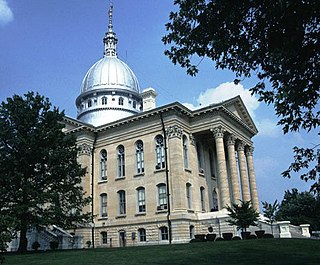
The Carlinville Historic District includes the oldest sections of Carlinville, Illinois. The district consists of much of central and eastern Carlinville and is roughly bounded by Oak Street, Mulberry Street, Morgan Street, and the eastern city limits. The Macoupin County Courthouse, a Beaux-Arts building built in 1867–70, is the focal point of the district. The courthouse is situated in a public square in downtown Carlinville and is surrounded by some of the city's oldest businesses. The district also includes large residential sections; popular architectural styles in these areas include Federal, Greek Revival, Italianate, and Queen Anne.
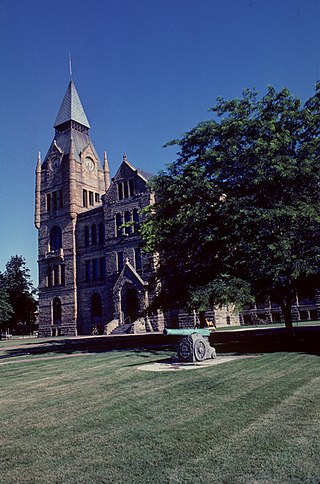
The Galesburg Historic District is a 496-acre (201 ha) historic district in Galesburg, Illinois. The district includes 1049 contributing buildings and contains the town's original plat as well as several older neighborhoods. The section of the district south of North Street encompasses Galesburg's historic city center and its most significant landmarks, such as the Knox County Courthouse, the Knox County Jail, the Burlington Depot, and Main Street's commercial buildings. Knox College, the school Galesburg was founded to serve, and its historic Old Main are also located in the southern half of the district. The area north of North Street is mainly residential and is dominated by Queen Anne and Classical Revival houses, including many transitional houses displaying elements of both styles.

The Winchester Historic District is a historic district which encompasses much of the developed area of Winchester, Illinois. The district includes 438 buildings, of which 273 are contributing buildings. Winchester's historic area represents a typical small, rural county seat; its commercial development is focused around the county courthouse and town square, while low- to moderate-density residential development can be found away from the commercial center. Development in the district began in the 1830s; by the 1870s, most of the significant buildings had been completed. The district's older buildings are mainly designed in the Federal and Greek Revival styles, while its later buildings mostly have Italianate designs. The Greek Revival Presbyterian Church stands out among these traditionally-styled buildings; according to the Illinois Historic Structures Survey, it is the most exceptional Greek Revival church in any Illinois city of over 500 people. The Scott County Courthouse, a late addition to the district in 1885, has also been noted as architecturally significant, though its design does not conform to a single style.
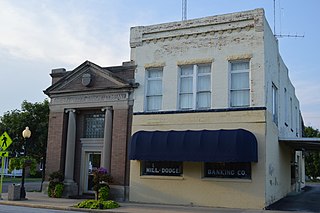
The Warsaw Historic District is a historic district encompassing the inner core of Warsaw, Hancock County, Illinois. As the city has lost many of its outlying residential areas, the district includes nearly all of the town's developed area, which has been relatively unchanged since the late 19th century. The city was settled in the 1810s and 1820s as a military outpost on the Mississippi River and was platted in 1833. As an economically significant port city, the town grew steadily until the 1870s, reaching a peak population of 5,000 to 15,000 people; it has declined since and now has less than 2,000 residents. The town's historic buildings include a commercial core along Main Street and low-density residential areas in the rest of the district. The Greek Revival, Federal, and Italianate architectural styles are all well-represented among the district's buildings.

The historic Chicago park and boulevard system is a ring of parks connected by wide, planted-median boulevards that winds through the north, west, and south sides of the City of Chicago. Neighborhoods along this historic stretch include Logan Square, Humboldt Park, Garfield Park, Lawndale, Little Village, McKinley Park, Brighton Park, Gage Park, Englewood, Back of the Yards, and Bronzeville. It reaches as far west as Garfield Park and turns south east to Douglass Park. In the south, it reaches Washington Park and Jackson Park, including the Midway Plaisance, used for the 1893 World's Fair.

The Rockton Historic District is a national historic district which encompasses much of the village of Rockton, Illinois. The district includes 208 buildings, most of which are residential; the town's commercial district was purposefully excluded from the district due to its loss of historic integrity. Greek Revival is the only architectural style used widely within the district, with 51 buildings designed in the style. Rockton was founded in 1835 by William Talcott, and most of the village's development took place between then and the Civil War. This period of development coincided with an economic boom brought by short-lived steamboat and railroad projects; by the 1870s, Rockton had been bypassed by the major railroads and was losing citizens to its more prosperous neighbors, stalling its growth.
The Walnut Street Historic District is a nationally recognized historic district located in Waterloo, Iowa, United States. It was listed on the National Register of Historic Places (NRHP) in 2019. At the time of its nomination the district consisted of 111 resources, including 91 contributing buildings and 20 non-contributing buildings. The district is largely a residential area located between the central business district and the former location of the Illinois Central Railroad round house and shops. The neighborhood was originally platted as the Railroad Addition in 1860 and as the Cooley Addition in 1865. Buildings date from c. 1880 to 1981. Single-family houses are largely wood-frame construction with a few brick. Architectural styles include Queen Anne, Italianate, Shingle, Bungalow, variations on the American Foursquare, and those in a vernacular mode. Multi-family dwellings include double houses, identical houses, and apartment buildings. There are also a few commercial buildings on East Fourth Street and two churches. Walnut Street Baptist Church (1908) is individually listed on the NRHP. Two local architects, Mortimer Cleveland and Clinton Shockley have buildings in the district.





















